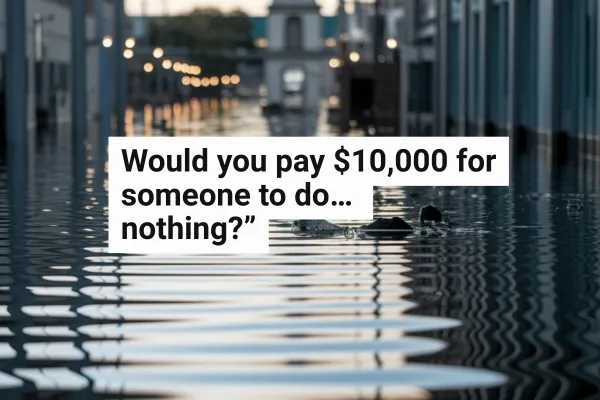Newsletters

Would You Pay $10,000 for someone to do ... nothing?
When flood damage hits, you want to get every dollar you’re entitled to — fast.
So it’s no surprise that many property owners turn to public adjusters to help maximize their flood claim.
But here’s what most people don’t realize:
If you don’t fully understand what’s in that public adjuster’s contract — you could end up paying thousands for nothing.
A Real Story from the Field
I recently spoke with a property owner who had been through multiple flood claims.
Her logic made sense:
“Last time I had a flood, the insurance adjuster missed a lot. The public adjuster came in and got me double. So this time, I brought one in again.”
But the result was very different.
This time, the NFIP adjuster got the claim right. The estimate was complete.
There were no major missed items. No additional payment. No extra money from FEMA.
But under her contract with the public adjuster — she still owed him 10% of the full claim value.
Not just the difference. Not the supplement. The whole thing.
She told me:
“He didn’t get me any more money. I did everything myself. But I still owe him thousands.”
And that’s when I explained the key mistake:
The contract should’ve said:
“10% of any additional payment recovered — not the full claim amount.”
Why This Happens
Most people don’t understand that NFIP flood insurance is limited in scope.
It’s not like a homeowners policy that’s designed to “make you whole again.”
NFIP pays for what’s covered — and only what’s covered.
That means:
If the adjuster does a solid job from the start, there may be no room to get additional funds.
Even the best public adjuster can’t make FEMA pay for what isn’t in the policy.
So if your contract pays the public adjuster a percentage of everything, regardless of outcome — you could be writing a large check for no added value.
Public Adjusters Can Be Valuable — When Used Strategically
I want to be clear:
Public adjusters aren’t the problem.
Hiring one can be a smart move — when the initial estimate is incomplete, low, or you don’t know how to push for supplements.
But like anything else in flood claims, you need the right contract and the right expectations.
What You Should Do Before Hiring a Public Adjuster:
✅ Read the contract word-for-word.
Make sure payment is tied to performance — not just the total claim.
✅ Negotiate terms that make sense:
→ “10% of any additional funds recovered after the initial insurance offer.”
→ Not “10% of the entire claim, regardless of outcome.”
✅ Understand NFIP limitations.
If FEMA won’t pay for it — no public adjuster can change that.
✅ Ask a flood consultant if the estimate is already solid. You may not need outside help at all.
Final Word:
Hiring a public adjuster isn’t a bad move — but it can be an expensive one if the contract isn’t clear.
Know what you’re agreeing to.
Understand what’s actually possible under the NFIP policy.
And always make sure your dollars are working for you — not against you.
💬 Need help reviewing your flood claim, estimate, or adjuster contract?
👉 Book a free consultation and let’s make sure you’re protected before you sign anything. [Schedule Your Call Here]

